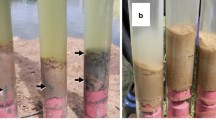Abstract
The depth distribution of oligochaetes was studied in a quaking marsh at Tinure, Co. Louth, Ireland. The dominant plants were grasses which formed a fibrous mat floating on semi-liquid peat. The water level remained near the surface except for a few weeks in winter and early spring when up to 50% surface cover of water was seen. Depth profiles of pH and redox potential showed seasonal variations with the anaerobic layer approaching the surface in summer. Oligochaetes were the most important group of invertebrates and were represented by 7 species of Naididae, 7 Tubificidae, 2 Lumbriculidae, 13 Enchytraeidae and 1 Lumbricidae. Lumbricids and most species of Enchytraeidae were concentrated at the surface but the enchytraeids Marionina riparia, Cernosvitoviella spp. and Cognettia glandulosa were frequent in the anaerobic layer. Aquatic oligochaetes were most numerous below the surface. Tubificids penetrated further than other groups and reached a peak at 4–6 cm. The effects of lowering the water level were studied in pot cultures where water was maintained at 4 different levels. Enchytraeids always remained near the surface, while aquatic oligochaetes concentrated nearer the water level. It is concluded that enchytraeids are prevented from colonizing most freshwater habitats by their inability to tolerate extended periods of anoxia.
Similar content being viewed by others
References
Berg, K., 1938. Studies on the bottom animals of Esrom Lake. K. Danske Vidensk. Selsk. Skr. Nat. Mat. Afd. 9, 8: 1.225.
Boelter, D. H., 1969. Soil and water management and conservation. Soil Sci. Soc. Amer. Proc. 33: 600–609.
Brinkhurst, R. O., 1970. Distribution and abundance of Tubificid (Oligochaeta) species in Toronto Harbour, Lake Ontario. J. Fish. Res. Bd., Canada 27: 1961–1969.
Brinkhurst, R. O. & C. R. Kennedy, 1965. Studies on the biology of the Tubificidae (Annelida, Oligochaeta) in a polluted stream. J. Anim. Ecol. 34: 429–443.
Cole, G. A., 1953. Notes on the vertical distribution of organisms in the profundal sediments of Douglas Lake, Michigan. Amer. Midl. Nat. 49: 252–256.
Dendy, J. S., 1965. The use of woods to determine the depths of oxygen distribution in ponds. Prog. Fish Cultst. 27: 75–78.
Erman, D. C., 1973. Invertebrate movements and some diel and seasonal changes in a Sierra Nevada peatland. Oikos 24: 85–93.
Farnham, R. S. & H. R. Finney, 1965. Classification and properties of organic soils. Adv. Agron. 17: 115–162.
Gambrell, R. P. & W. H. Patrick Jr., 1978. Chemical and microbiological properties of anaerobic soils and sediments. In: D. D. HookandR. M. M. Crawford (eds) Plant life in anaerobic environments. Ann. Arbor Sci. Publ. Ann. Arbor, Michigan: 375–423.
Giani, N. & P. Lavandier, 1977. Les oligochètes du torrent d'Estaragne (Pyrénnées Centrales). Bull. Soc. Hist. rat. Toulouse 113: 234–243.
Healy, B., 1979. Records of Enchytraeidae (Oligochaeta) in Ireland. J. Life Sci. R. Dubl. Soc. 1: 39–70.
Healy, B. & T. Bolger, 1984. The occurrence of species of semiaquatic Enchytraeidae (Oligochaeta) in Ireland. Hydrobiologia 115: 157–170.
Kasprzak, K., 1987. Oligochaetes (Annelida) of the eulittoral zone of lakes (this volume).
Milbrink, G., 1973. On the vertical distribution of oligochaetes in lake sediments. Rep. Inst. Freshwat. Res. Drottingholm 53: 34–50.
Milbrink, G., 1980. Oligochaete communities in pollution biology: the European situation with special reference to lakes in Scandinavia. In: R. O. BrinkhurstandD. G. Cook (eds), Aquatic Oligochaete Biology. Plenum Press, New York: 433–455.
O'Connor, F. B., 1955. Extraction of enchytraeid worms from a coniferous forest soil. Nature, Lond. 175: 815–816.
O'Sullivan, A. M., 1968. The lowland grasslands (Molinio-Arrhenatheretea) of County Limerick. An Foras Talúntais, Dublin, 57 pp.
Sarkka, J. & L. Paasivirta, 1972. Vertical distribution and abundance of macro- and meiofauna in the profundal sediments of Lake Päijänne, Finland. Ann. zool. fenn. 9: 1–9.
Verdonschot, P. F. M., 1984. The distribution of oligochaetes in the fenland area of N.W. Overijssel (The Netherlands). Hydrobiologia 115: 215–222.
Author information
Authors and Affiliations
Rights and permissions
About this article
Cite this article
Healy, B. The depth distribution of Oligochaeta in an Irish quaking marsh. Hydrobiologia 155, 235–247 (1987). https://doi.org/10.1007/BF00025656
Issue Date:
DOI: https://doi.org/10.1007/BF00025656




